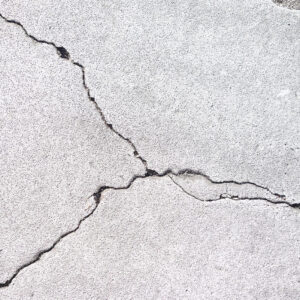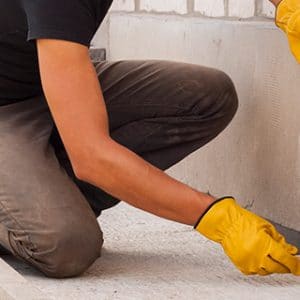Foundation cracks are more than just unsightly blemishes on your home’s structure; they are potential harbingers of serious issues that can compromise the safety, stability, and value of your property. These cracks can vary in size and severity, from hairline fractures that are barely noticeable to gaping fissures that threaten the integrity of your home.
The impact of foundation cracks on homeowners can be significant. They can lead to water intrusion, which not only causes damage to the interior of the home but also creates an environment conducive to mold and mildew growth, posing health risks to the occupants. Furthermore, if left unaddressed, these cracks can worsen over time, leading to more extensive and costly repairs.
Addressing foundation damage early is important. Early intervention can prevent minor issues from escalating into major problems, saving homeowners from the financial burden and stress of extensive repairs. Moreover, maintaining the integrity of your foundation ensures the safety and longevity of your home, protecting your investment and providing peace of mind.
Foundation Cracks Basics
 Foundation cracks are fractures or breaks in the concrete or masonry of a building’s foundation. These cracks can vary in size, shape, and direction, and they are a common issue faced by homeowners. While some cracks are purely cosmetic, others can indicate deeper problems that need immediate attention.
Foundation cracks are fractures or breaks in the concrete or masonry of a building’s foundation. These cracks can vary in size, shape, and direction, and they are a common issue faced by homeowners. While some cracks are purely cosmetic, others can indicate deeper problems that need immediate attention.
Common Causes of Foundation Cracks
- Soil Settlement: Over time, the soil beneath a foundation can settle or shift, causing uneven pressure on the foundation and leading to cracks.
- Hydrostatic Pressure: The buildup of water in the soil around the foundation can exert pressure on the walls, causing them to crack.
- Temperature Fluctuations: Extreme temperature changes can cause the materials of the foundation to expand and contract, leading to cracks.
- Poor Construction: Inadequate construction practices, such as using low-quality materials or improper curing of concrete, can make the foundation more susceptible to cracking.
- Tree Roots: The growth of tree roots near the foundation can exert pressure on the structure and cause cracks.
Signs and Symptoms to Watch For
- Visible Cracks: Any visible cracks in the foundation walls, floors, or around doors and windows should be inspected.
- Water Leakage: Water seeping through cracks in the basement or crawl space is a clear sign of a foundation issue.
- Doors and Windows: Difficulty in opening or closing doors and windows can indicate foundation movement.
- Uneven Floors: Floors that are sloping or feel uneven underfoot may be a sign of foundation settling.
- Wall Gaps: Gaps between walls and the ceiling or floor can signal foundation problems.
The Cost of Ignoring Foundation Cracks
Ignoring foundation cracks can seem like a minor oversight, but the repercussions can be anything but trivial. These seemingly innocuous fissures can evolve into serious problems, jeopardizing not only the integrity of your home but also its safety and financial value.
The cost of turning a blind eye to foundation cracks extends beyond immediate repairs, encompassing long-term damage, increased susceptibility to water intrusion, and potential health hazards.
Immediate and Long-Term Damage
Neglecting foundation cracks can lead to immediate and long-term damage to your home. Initially, small cracks might seem insignificant, but over time, they can widen and compromise the integrity of the foundation. This can result in uneven floors, cracked walls, and, in severe cases, the partial collapse of the structure. Addressing cracks early can prevent these serious issues and save homeowners from costly repairs.
Increased Risk of Water Damage and Flooding
Foundation cracks can act as pathways for water to enter your home, leading to water damage and flooding, especially during heavy rain or snowmelt. Water intrusion can damage flooring, furniture, and personal belongings. It can also weaken the foundation further, exacerbating existing cracks and creating new ones. By sealing cracks promptly, homeowners can mitigate the risk of water damage and protect their property.
Health Hazards from Mold and Mildew
Moisture seeping through foundation cracks can create a damp environment conducive to mold and mildew growth. Mold can spread quickly and is difficult to eradicate. It poses health risks, especially to individuals with allergies, asthma, or compromised immune systems. By addressing foundation damage and preventing moisture intrusion, homeowners can safeguard their family’s health and avoid the hassle and expense of mold remediation.
Decreased Home Value and Marketability
Foundation problems, including cracks, can significantly reduce the value of a home. Prospective buyers are often wary of purchasing a property with foundation issues due to the potential for future problems and expensive repairs. Additionally, homes with foundation damage may take longer to sell and may sell for less than their market value. By repairing foundation cracks and ensuring the integrity of the home, homeowners can maintain or even increase their property’s value and marketability
Professional Solutions for Foundation Cracks
 Addressing foundation cracks requires more than just a quick fix; it demands a professional approach that ensures lasting solutions and peace of mind.
Addressing foundation cracks requires more than just a quick fix; it demands a professional approach that ensures lasting solutions and peace of mind.
Diagnosis and Assessment
The first step in addressing foundation cracks is a thorough diagnosis and assessment by a professional. This involves inspecting the foundation to determine the extent of the damage, the type of cracks, and their underlying causes. A professional can also assess the potential risks to the structure and recommend the most appropriate repair method. Accurate diagnosis is crucial for effective and lasting repairs.
Repair Methods for Different Types of Foundation Cracks
Professional repair methods vary depending on the type and severity of the foundation issues. Common repair techniques include:
- Epoxy or Polyurethane Injection: Used for sealing hairline cracks to prevent water intrusion and further widening.
- Underpinning: In cases of significant settlement, underpinning may be necessary to stabilize and raise the foundation to its original level.
- Carbon Fiber Straps: For stabilizing bowing walls and preventing further movement.
- Drainage Solutions: Addressing water issues around the foundation to prevent hydrostatic pressure and future cracking.
Crackmasters‘ team of professional contractors can assess each unique situation and determine the most suitable repair method, ensuring a permanent solution for your foundation cracks.
Importance of Waterproofing
Waterproofing is crucial in safeguarding your home against future foundation cracks. It acts as a shield against water, reducing hydrostatic pressure and lessening the chance of water-related damage.
Crackmasters employs professional waterproofing techniques, which may include setting up both interior and exterior drainage systems, sump pumps, and applying waterproof coatings. To maintain their efficiency, these waterproofing systems require regular upkeep and inspection. By integrating crack repair with thorough waterproofing, homeowners can fortify their foundation against upcoming challenges and prolong the life of their home.
Preventative Measures for Homeowners
Maintaining the stability of your home’s foundation is essential for ensuring its longevity and safety. Proactive measures can help homeowners avoid the pitfalls of foundation damage before they escalate into costly repairs. From proper drainage to regular inspections, there are several steps you can take to keep your foundation in top condition and protect your investment.
Preventative measures not only safeguard your home’s structural integrity but also contribute to its overall health and value. By being vigilant and addressing potential issues early, you can prevent minor problems from turning into major concerns.
Tips for Maintaining a Strong Foundation
- Proper Drainage: Ensure that gutters and downspouts are clean and functioning properly to direct water away from the foundation. Install downspout extensions if necessary.
- Slope Grading: Maintain a positive slope around your home so that water flows away from the foundation, reducing the risk of water intrusion and soil erosion.
- Soil Moisture: Keep the soil around your foundation consistently moist, especially during dry periods, to prevent excessive soil contraction and expansion.
- Foundation Inspections: Conduct regular inspections of your foundation for signs of cracks or other issues. Early detection is key to preventing serious problems.
- Vegetation Control: Keep trees and large shrubs at a safe distance from your foundation to prevent root intrusion and soil displacement.
- Repair Cracks Promptly: Even small cracks should be sealed promptly to prevent water intrusion and further damage.
When to Call in the Professionals for Foundation Cracks
- Visible Cracks: If you notice cracks in your foundation, especially if they are widening or accompanied by other symptoms, it’s time to consult a professional.
- Water Issues: If you have persistent water problems in your basement or around your foundation, professional intervention may be necessary to address the underlying cause.
- Structural Concerns: Signs of structural issues, such as uneven floors, doors and windows that won’t close properly, or gaps between walls and the ceiling, should be evaluated by a professional.
- Previous Repairs: If you’ve had foundation repairs in the past and are noticing new or recurring issues, it’s important to have a professional reassess the situation.
Safeguard Your Home
Addressing foundation cracks is not just a matter of aesthetics; it’s a crucial step in ensuring the structural integrity, safety, and value of your home. Ignoring these cracks can lead to severe and costly consequences, including damage, water issues, and health hazards. Taking proactive measures to maintain your foundation and seeking professional help when needed can prevent minor issues from escalating into major problems.
We encourage homeowners to be vigilant in monitoring their foundations and to act promptly at the first sign of trouble. Regular maintenance, proper drainage, and timely repairs are key to keeping your foundation strong and your home safe.
Contact Crackmasters for expert foundation crack repair and waterproofing services. Our team of professionals is dedicated to providing effective solutions to protect your home for years to come. Reach out to us for a consultation and take the first step toward a secure and dry basement.
Recent Posts
Ready to Sell? Common Basement Issues to Fix Before Listing
Preparing to sell your home involves more than just staging the living spaces and enhancing
Steps for a Comprehensive Basement Health Audit
Often overlooked, a healthy basement is a vital contributor to a safe and comfortable home
Common Causes of Foundation Leaks
Maintaining a dry basement is crucial not only for comfort but also as a fundamental

